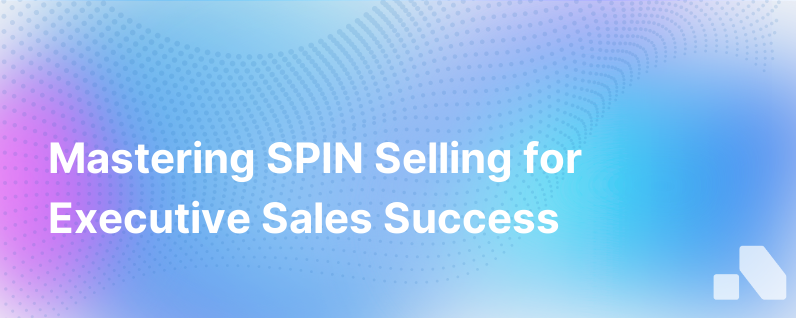Spin Selling
Published on July 11, 2023 by David Zhang
When it comes to effective sales strategies, SPIN Selling is a renowned methodology that has stood the test of time. Developed by Neil Rackham and introduced in his 1988 book, "SPIN Selling," this approach's effectiveness has been validated by over 30 years of real-world application and has informed the philosophies of countless successful sales professionals. It is rooted in the idea that understanding and addressing customer needs is critical for closing high-value sales.
Let's break down SPIN Selling to understand why it's such a powerful method for sales success, especially in complex B2B environments.
What is SPIN Selling?
SPIN Selling is an acronym standing for four types of questions: Situation, Problem, Implication, and Need-payoff. Rackham’s research, which analyzed over 35,000 sales calls, discovered that the most successful sales reps were those who asked insightful questions that not just understood a customer's needs, but also made the customer understand those needs. SPIN Selling flips the traditional sales approach on its head —instead of starting with the product, it starts with the customer.
Breaking Down the SPIN Questioning Framework
Situation Questions
The foundation of the SPIN methodology rests on situational questions. These queries aim to help the salesperson gather facts about the customer's current environment and context. Situation questions are fairly straightforward and might include inquiries about the company’s size, structure, current equipment, or software systems. It's about getting an overall picture of where the customer is right now. However, there is a caution to be heeded here: too many situational questions can bore or irritate the customer. They are necessary, but the real magic lies in the subsequent types of questions.
Problem Questions
These questions get to the heart of the customer's challenges, difficulties, and dissatisfactions with their current situation. They are more probing and are designed to uncover pain points. For example, a salesperson might ask, "Are you facing any challenges with your current software’s load time?" The objective here is to get customers talking about their problems, which sets the stage for the next set of questions.
Implication Questions
Implication questions are where skilled salespeople differentiate themselves. These probing questions take identified problems and explore their effects or consequences, making the issues more acute and urgent in the process. For example, "How do the load times you mentioned earlier impact your team's productivity?" Implication questions amplify the problem in the customer’s mind, which then makes your solution appear more valuable.
Need-Payoff Questions
Lastly, these are the questions that get the customer to explain the benefits that would come from solving the problem. Instead of the salesperson asserting the value of their product or service, these questions let the customer articulate the benefits, increasing their buy-in. For instance, "How would it affect your day-to-day operations if load times were no longer an issue?" Such a question not only highlights the benefits of a solution but also helps the customer visualize a future where their problem is solved.
The Power of SPIN Selling In B2B Sales
In B2B sales, the length of sales cycles, the complexity of products and services, and the sophistication of the buyers make the SPIN Selling methodology particularly potent. High-value sales are rarely impulsive decisions, they are considered purchases where the sales rep must act as a consultant, uncovering and amplifying problems while helping the client understand the full implications before they can present a solution.
SPIN questions can uncover needs the customer wasn’t fully aware of, which is vital in selling B2B solutions that can be multi-layered and highly technical. The depth and value of discussions are improved, ensuring that discussions are focused on the business value and strategic importance, rather than just features and functions.
Implementing SPIN Selling Strategy
To effectively implement SPIN Selling, training and practice are essential. Sales teams need to understand the process, the theory behind it, and how to apply it in different stages of the sales process. Some key implementation steps include:
-
Role-Playing: Simulate sales scenarios to get comfortable with asking different types of SPIN questions and responding to various answers.
-
Active Listening: Teach sales reps to listen actively to customer responses to uncover deeper issues and opportunities.
-
Customization: Encourage reps to adapt the SPIN framework to the specific context of their customer, avoiding a one-size-fits-all approach.
-
Patience: Remind teams that SPIN Selling is about the long game—developing a deep understanding of customer needs takes time but pays off in larger and more successful sales.
-
Refinement: Continuously refine questions based on what's working and what's not, and stay updated on industry trends and customer environments.
The Role of Tools and AI in SPIN Selling
The value of SPIN Selling can be further enhanced by using modern tools and technology. Artificial intelligence (AI)-driven CRMs and sales platforms, such as Aomni, can rapidly process vast quantities of data to provide deeper insights into customer behavior, buying signals, and potential pain points. These platforms can also track the success rates of different types of questions and help tailor the approach to individual prospects. This equips sales reps with the right information at the right time, enabling them to ask more impactful questions and to do so with confidence.
Conclusion
SPIN Selling remains a powerful methodology for sales professionals, particularly in complex B2B environments. By focusing on understanding and addressing customer needs through a strategic questioning process, sales reps can build more meaningful relationships with customers, uncover deeper sales opportunities, and close more deals. While the SPIN framework provides the foundations, modern tools like Aomni can accentuate its effectiveness, offering an array of data-driven insights at a sales rep’s fingertips, thus enabling a smarter, more informed sales process.